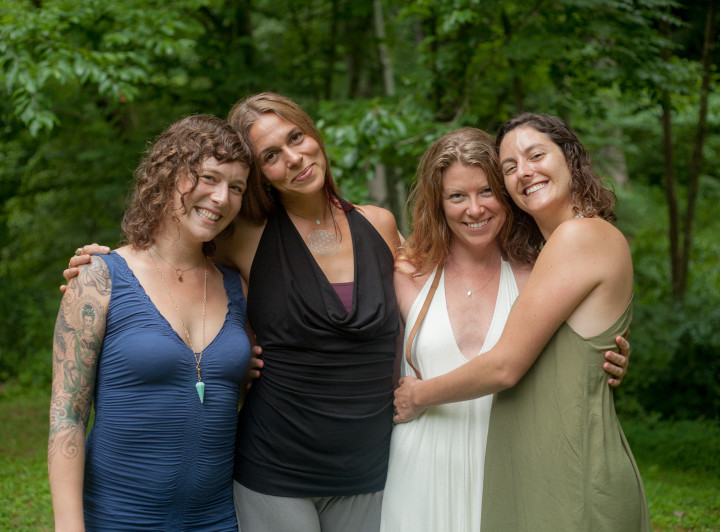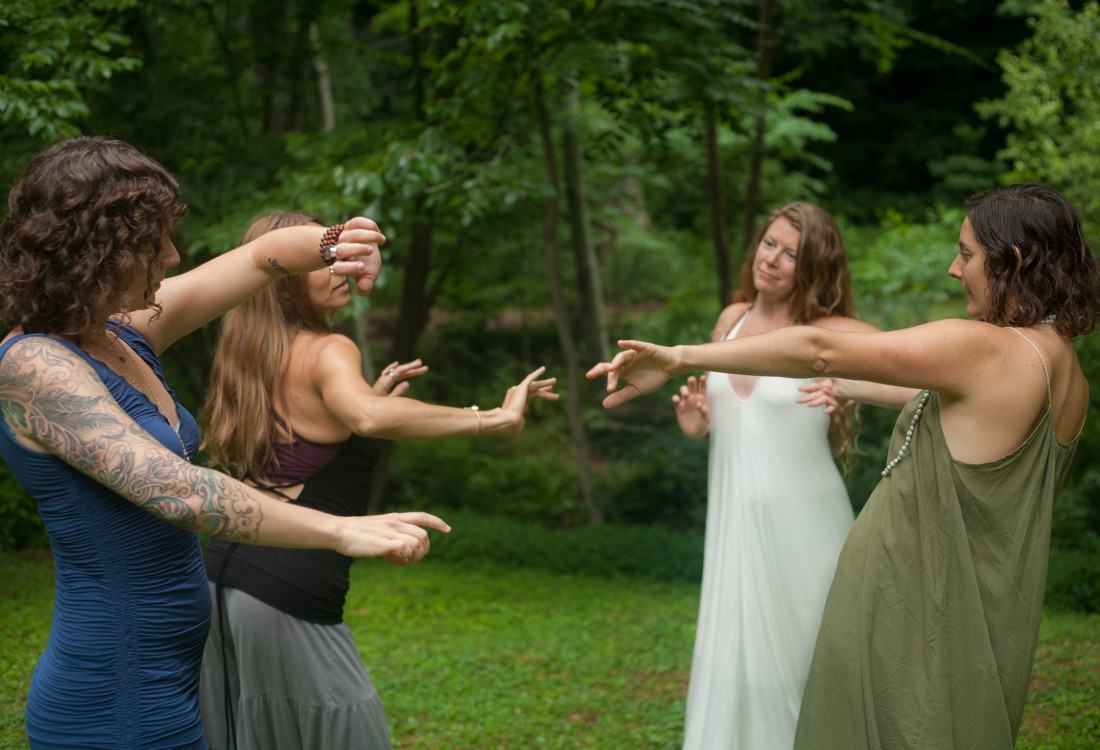One of Asheville’s newest activities embraces dance, yoga, shamanic ritual, pilgrimage and community connection, says local astrologer Virginia Rosenberg. It’s called Qoya (pronounced COY-uh), and “the guiding principle is there is no way you can do it wrong,” she says. ‘Qoya,’ which means ‘queen’ in Quechuan, a pre-Incan language in Peru, captures the empowerment women feel when they practice this form of movement.
Rosenberg introduced Qoya to the Asheville area, but it was developed for women by yoga teacher and dancer Rochelle Schieck. She calls the movement practice a way of “remembering through movement that our essence is wise, wild and free. ”
Schiek held two recent Qoya workshops and teacher training in Asheville July 16-17, says Rosenberg.
“We focus less on how something looks and more on how it feels,” she says. “The way you know you are doing it right is that it feels good and true to you.”
Like swimming in the French Broad River or dancing with your girlfriends, “Qoya is something you want to do, not just because you will feel good or because it is good for you, but because you want to,” says local Qoya teacher Kitty Cavalier, author of “Sacred Seduction.”

“My whole life, I tried to exercise like a good girl,” she says. “I did aerobics, took runs in the park, [practiced] yoga [and] endured torturous, sleep-deprived mornings at the gym, where I would run full-tilt toward myself in a mirrored wall in front of the treadmill. But the truth was, all I really wanted to do was run as far away from myself as I possibly could.”
Cavalier says that exercise had become “little more than atonement, a way of trying to right the wrongs of this feminine body that was always too fat, too pale, just … not right.”
Instead of feeling better after working out, she found that exercise only perpetuated an internal dialogue that revealed how deeply unhappy she was with herself and her body.
For fellow Qoya teacher Lyndsey Azlynne, “Qoya is a tool for self-discovery … using dance as a metaphor and an oracle to reveal deeper aspects of who we are.”
Schiek notes, “With Qoya we often say, ‘Come as you are, leave as more of who you are.’” Qoya classes are designed to cultivate a sense of inner knowing, she says.
Another local teacher, Caroline Padgett, says, “More times than not, women (and a couple of men) have felt deep gratitude for the freedom and insight they gained within themselves.”
Classes follow a rough outline usually held together around a theme, says Schiek, such as “setting an intention, circling, heart opening, hip opening, dancing our yoga as prayer, dancing with the shadow of the theme, shamanically shaking it out, learning some simple choreographed steps (like the Charleston or the Grapevine), embodying the theme with free dance, sharing the experience with a partner, final stretching and then a deep relaxation.”
It’s all done to a soundtrack that may take participants from India to the Lower East Side, up to the heights of heaven and back down to the dance floor of “Soul Train.” “The music is a collection of everything, because Qoya is a collection of everything,” says Cavalier.
“The arc of the class is truly a journey inward and deep medicine for the heart and soul,” she says.
Qoya naturally brings people together in such a way that they can be exactly who, how and where they are in their lives, says Rosenberg. “The shadow component is one of the connective parts of the class, because when you see someone at their worst, or when real shit goes down, those are the experiences that bring us closer together,” she explains.
Azlynne says, “The shadow dance is where we consciously visit the aspects of ourselves and our inner worlds that might often be repressed, hidden or avoided. This can be a very tender part of class and is meant to be a little bit uncomfortable.”
Participants “are coming together to feel; generally, if people feel, when they feel, it’s often in isolated places, in the isolation of their home,” she says.
For Padgett, the space to feel was instrumental in her own healing journey. “I had lost a child and almost my own life during childbirth earlier in the year and was in an intense healing process physically and emotionally,” she says.
Padgett had hesitated to sign up for any kind of dancing retreat but says that attending one with Schieck was just what she needed. “I was able to be right where I was in my pain, in my grief, in my gratitude, in my joy. When I felt physically tired during class, I could curl up in a ball and cry and it really was OK, and I felt I was still doing Qoya, since the beauty of the Qoya invitation is one of deep listening.”
Rosenberg says, “That’s why [Qoya] feels like family; that’s why it’s different than a relationship with your neighbors or people you see every day. We don’t even have to talk about it or look at each other, but we dip into that space together.”
“More importantly than feeling good is that it feels honest. It feels resonant,” says Schieck. “People can expect a supportive, encouraging group of people gathered in a circle, exploring the class theme through the feeling in the body.”
“To say Qoya is a movement class is like saying the ocean is made up of a few raindrops. True, but not the whole story,” says Cavalier.
“Qoya is a spiritual temple, a shamanic journey and the dance party you have always dreamed of. It is communing with the very throb and heartbeat of life through your very own skin and bones,” she continues.
“You know the feeling you get when you see a gorgeous garnet sunset? Or hear a baby’s giggle? Or see a three-legged dog wagging its tail? Or witness a rainstorm in the jungle? These are the moments when we remember. We remember that life is magic and mysterious, and we feel humbled to be a part of it.
“Qoya is a form of exercise, but at its essence, Qoya is a way of accessing this sacred remembrance any time we want it. Through movement we remember that we are all wise, wild and free.”
MORE INFO
For updates on Qoya workshops and classes in Asheville, visit the Qoya Asheville Facebook Group.
For more information about Qoya, visit qoya.love.



Greedo spoke a simplified form of Quechua when conversing with Han Solo in Star Wars pt IV.
Han still shot first, mind you as Greedo had it coming.
“Yoga changed my life by giving me a job … for making me teach yoga,I feel so good, so calm. I feel like I have the very biggest family ever. Family is not about blood, it is about connection with people or info http://www.yogabhawnamission.com/yogapractice-hall.html
\”